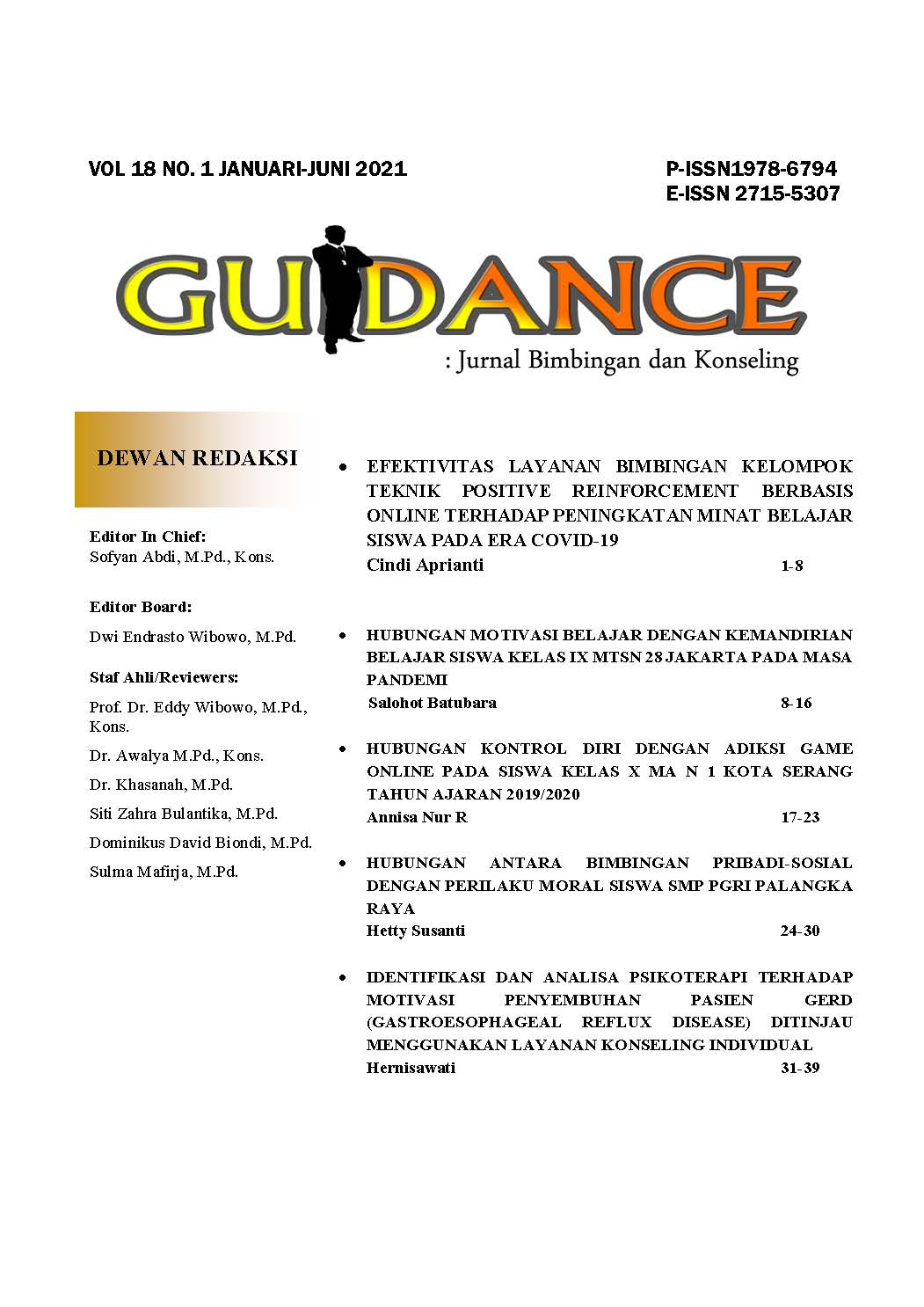Gambaran Perilaku Non-Suicidal Self-Injury (NSSI) Pada Siswa SMAN 1 Bogor
Abstract
Late adolescence to early adulthood is called a problematic period. Self-injury is an attempt to avoid distressing thoughts, feelings, or internal experiences by intentionally injuring oneself without suicidal intent. The purpose of this study was to describe the behavior of NSSI among students in SMAN 1 Bogor. The research method used is qualitative research with in-depth interviews and observational models. The research subjects were two people using a purposive sampling technique. The data collection technique used was the SelfHarm Behavior Questionnaire (SHBQ) and the results of an IPA (interpretative phenomenological analysis) analysis. The results of research on NSSI behavior were triggered by negative treatment received, such as bullying and a lack of acceptance and support from parents, so there was a feeling of pressure and not being accepted. NSSI is carried out to reduce tension and divert negative feelings until there are attempts to end one's life with a suicide attempt. The weakness of this study is that it only provides an overview of NSSI behavior and doesn’t provides interventions for resolution and prevention of NSSI behavior
References
Chapman, A. L., Gratz, K. L., & Brown, M. Z. (2006). Solving the puzzle of deliberate self-harm: The experiential avoidance model. Behaviour Research and Therapy, 44, 371–394. https://doi.org/10.1016/j.brat.2005.03.005
Elvira, S. R., & Sakti, H. (2021). Eksplorasi Pengalaman Nonsuicidal Self-Injury (Nssi) Pada Wanita Dewasa Awal: Sebuah Interpretative Phenomenological Analysis. Jurnal Empati, 10(5), 319–327. https://doi.org/10.14710/empati.2021.32933
Estefan, G., & Wijaya, Y. D. (2004). Gambaran proses regulasi emosi pada pelaku. Jurnal Psikologi, 12(1), 26–33. https://media.neliti.com/media/publications/126410-ID-gambaran-proses-regulasi-emosi-pada-pela.pdf
Farley, H. R. (2020). Assessing mental health in vulnerable adolescents. Nursing, 50(10), 48–53. https://doi.org/10.1097/01.NURSE.0000697168.39814.93
Gutierrez, P. M. (1998). Self-Harm Behavior Questionnaire (SHBQ). Unpublished manuscript, North- ern Illinois University, DeKalb.
La Kahija, Y. F. (2017). Penelitian fenomenologis: Jalan memahami pengalaman hidup. PT. Kanisius.
Madjar, N., Daka, D., Zalsman, G., & Shoval, G. (2021). Depression symptoms as a mediator between social support, non-suicidal self-injury, and suicidal ideation among Arab adolescents in Israel. School Psychology International, 0(0), 1–21. https://doi.org/10.1177/0143034321998741
Maidah, D. (2013). Self Injury Pada Mahasiswa (Studi Kasus Pada Mahasiswa Pelaku Self Injury). Development and Clinical Psychology, 2(1), 6–13. https://journal.unnes.ac.id/sju/index.php/dcp/article/view/2088
Malumbot, C. M., Naharia, M., & Kaunang, S. E. J. (2020). Studi Tentang Faktor-Faktor Penyebab Perilaku Self Injury Dan Dampak Psikologis Pada Remaja. Psikopedia, 1(1), 15–22. https://doi.org/10.36582/pj.v1i1.1612
Mazelis Ruta. (2008). Self-injury: Understanding and responding to people who live with self-inflicted violence. National Center for Trauma-Informed Care (NCTIC), 1–12. https://www.theannainstitute.org/Self Injury.pdf
Muehlenkamp, J. J., Cowles, M. L., & Gutierrez, P. M. (2010). Validity of the self-harm behavior questionnaire with diverse adolescents. Journal of Psychopathology and Behavioral Assessment, 32(2), 236–245. https://doi.org/10.1007/s10862-009-9131-7
Nock, M. K., & Mendes, W. B. (2008). Physiological Arousal, Distress Tolerance, and Social Problem-Solving Deficits Among Adolescent Self-Injurers. Journal of Consulting and Clinical Psychology, 76(1), 28–38. https://doi.org/10.1037/0022-006X.76.1.28
Patchin, J. W., & Hinduja, S. (2017). Digital Self-Harm Among Adolescents. Journal of Adolescent Health, xx(x), 1–6. https://doi.org/10.1016/j.jadohealth.2017.06.012
Prasanti, D., & Prihandini, P. (2019). Fenomena aksi menyakiti diri bagi remaja dalam media online (Analisis teori konstruksi sosial dalam fenomena aksi menyakiti diri bagi remaja dalam media online Tirto.id). Jurnal Nomosleca, 5(2), 126–138. https://doi.org/10.26905/nomosleca.v5i2.3226
Putri, T. H., Priyono, D., & Fitrianingrum, I. (2022). Coping Strategies Among Indonesian College Students During the Covid-19 Pandemic. Malaysian Journal of Medicine and Health Sciences, 18(6), 100–107. https://doi.org/10.47836/mjmhs18.6.15
Rodav, O., Levy, S., & Hamdan, S. (2014). Clinical characteristics and functions of non-suicide self-injury in youth. European Psychiatry, 29(8), 503–508. https://doi.org/10.1016/j.eurpsy.2014.02.008
Safaria, Triantoro & Saputra, N. E. (2009). Manajemen Emosi: Sebuah Panduan Cerdas Bagaimana Mengelola Emosi Positif Dalam Hidup Anda. Jakarta: Bumi Aksara.
Staiger, T., Waldmann, T., Rüsch, N., & Krumm, S. (2017). Barriers and facilitators of help-seeking among unemployed persons with mental health problems: A qualitative study. BMC Health Services Research, 17(39), 1–9. https://doi.org/10.1186/s12913-017-1997-6
Stallman, H. M. (2020). Health theory of coping. Australian Psychologist, 55(4), 1–12. https://doi.org/10.1111/ap.12465
Tresno, F., Ito, Y., & Mearns, J. (2012). Self-Injurious Behavior and Suicide Attempts Among Indonesian College Students. Death Studies, 36(7), 627–639. https://doi.org/10.1080/07481187.2011.604464
Zakaria, Z. Y. H., & Theresa, R. M. (2020). Faktor-Faktor Yang Memengaruhi Perilaku Nonsuicidal Self-Injury (NSSI) Pada Remaja Putri. Jurnal Psikologi Sains Dan Profes, 4(2), 85–90. https://doi.org/10.24198/jpsp.v4i2.26404
Zetterqvist, M., Lundh, L. G., Dahlström, Ö., & Svedin, C. G. (2013). Prevalence and function of non-suicidal self-injury (NSSI) in a community sample of adolescents, using suggested DSM-5 criteria for a potential NSSI disorder. Journal of Abnormal Child Psychology, 41(5), 759–773. https://doi.org/10.1007/s10802-013-9712-5
Copyright (c) 2023 Afra Hasna

This work is licensed under a Creative Commons Attribution 4.0 International License.

















